Writesonic markets itself as a platform for tracking and boosting your brand’s visibility in AI search. But can a tool that’s primarily designed for traditional search engine optimization and AI content generation truly compete as an AI visibility tracker?
I tested Writesonic’s AI search visibility suite to see how its prompt monitoring, sentiment tracking, and suggested actions work—and how it performs compared to more established AI visibility platforms.
In this Writesonic review, I’ll cover what you can expect from the platform’s AI search visibility tools, what users say about it, and pros and cons. I’ll also detail when to consider an AI visibility tool like Profound instead.
Writesonic review TL;DR
- Writesonic tracks the basic metrics you need to understand how your brand performs in AI search: prompts, citations, and sentiment. It also monitors your competitors, helping you spot opportunities to get ahead.
- It surfaces AI visibility opportunities and suggests content generation and optimization ideas to improve performance in AI search. But these tools are only available in the Enterprise plan—making Writesonic one of the most expensive AI visibility tools.
- It’s primarily an SEO and AI content generation tool, not an AI visibility tool. All AI search plans include a long list of SEO and generative AI features that you might not need or use if your goal is improving AI visibility.
Pros and cons of Writesonic
Here’s a quick overview of Writesonic’s biggest advantages and shortcomings.
Writesonic pros
- AI bot analytics: Writesonic connects to your website to track how ChatGPT, Gemini, and Perplexity see and navigate your content. This helps you understand which pages get the most traffic and drive the results that matter to your brand, but it only supports limited platforms compared to Profound.
- Actionable recommendations: It identifies opportunities to earn brand mentions, get citations, and outperform competitors. However, these opportunities are only available with the platform’s Enterprise plan.
- Built-in content generation: When you find an AI visibility opportunity, you can act on it and draft content without leaving the platform. However, you’d need Writesonic’s Enterprise plan to identify these opportunities automatically.
- All-in-one search optimization platform: It monitors more than just AI visibility. Writesonic also offers SEO-focused site audits, content strategies, and AI-powered content generation as well as content repurposing and optimization.
Writesonic cons
- Low-quality content: Writesonic originally launched as an AI writing tool, but the quality of its content is far from top tier. Briefs and drafts both appear unoriginal, and the writing lacks a humanlike quality.
- High price for limited AI features: With its starting fee of $249/month, Writesonic is one of the priciest AI visibility tools. Because most of its AI search features are only available in higher tiers, you could expect to pay at least $499/month.
- Lack of enterprise-grade security: Many of Writesonic’s premium AI search features are only available with the Enterprise plan. But the platform doesn’t provide enterprise-grade security and compliance, making the platform stability questionable.
- Limited integrations: The platform works with Zapier, Google Analytics, Google Search Console, and select website providers. But it lacks deep integrations with BI, CDP, and collaboration tools, instead relying on an API for custom connections.
Writesonic growth and fundraising history
Writesonic was founded in 2021, and the first version launched in 2022 as an AI writing tool. Over the years, the platform has rolled out a wide range of SEO and AI capabilities.
It now offers site audits and content strategies for traditional search. And as of mid-2025, it also offers AI visibility tools.
The company has raised $2.6 million across two seed stage funding rounds. Writesonic last raised in 2022.
In contrast, Profound has raised a total of $58.5 million across three funding rounds since the company was founded in 2024. Profound raised a $3.5 million seed round in August 2024, a $20 million Series A in June 2025, and a $35 million Series B in August 2025.
Prompt, citation, and sentiment analytics
With its sentiment, prompt, and citation monitoring, Writesonic has relatively thorough AI visibility tracking. Let’s walk through what the AI search visibility suite offers.
Prompts
Writesonic’s visibility trends and AI visibility leaderboard charts give you a quick overview of how your brand is performing compared to the competition. This is helpful for making sure you’re staying ahead of the curve and avoiding losing ground.
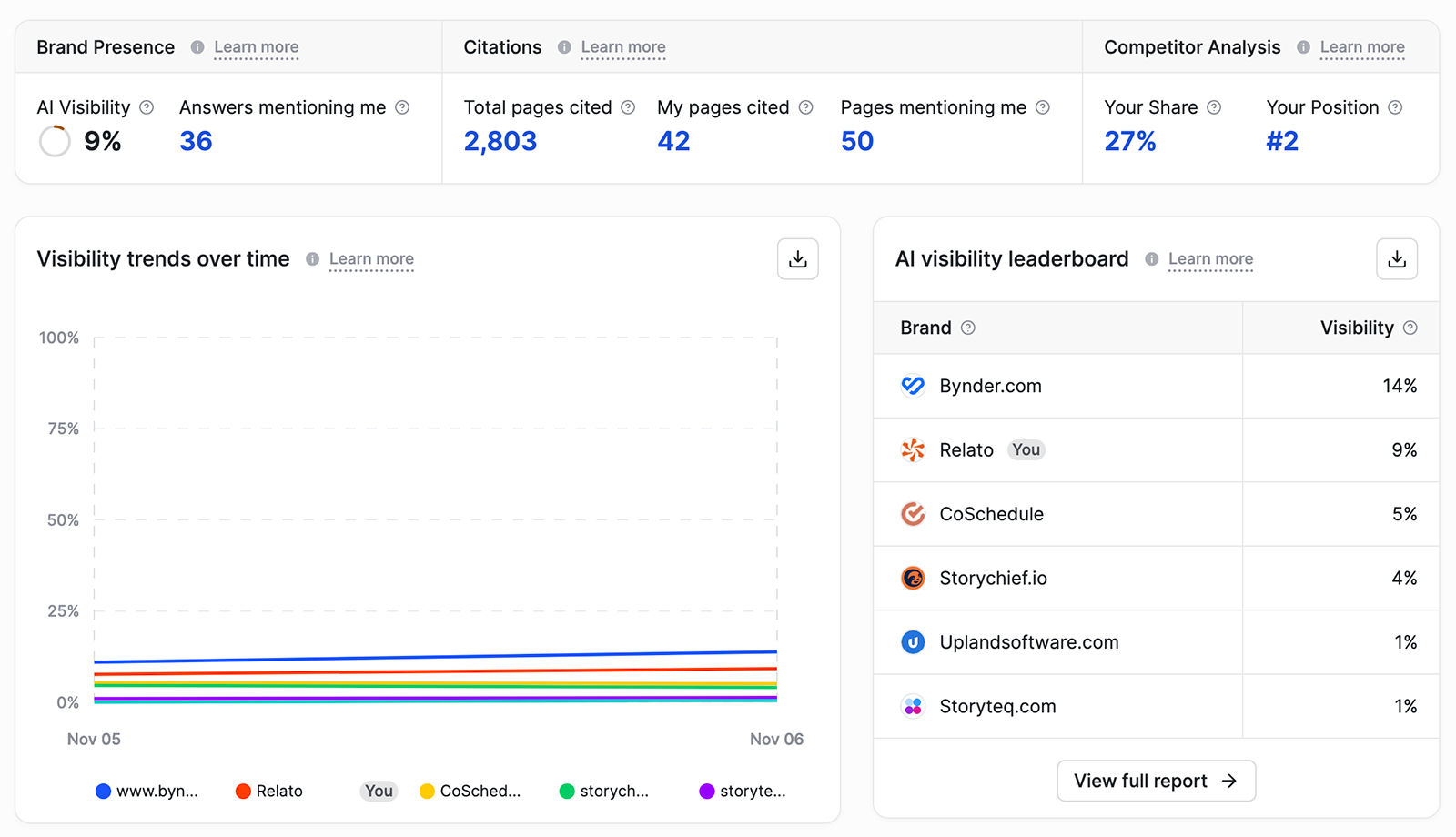
It also shares top prompts that drive visibility for your brand. You can drill down into the full list of relevant prompts and sort by topic to get a sense of your visibility. But there’s no overall visibility metric for each topic you’re tracking.

You can view AI answers for relevant prompts, which is helpful for understanding how and why your brand is mentioned by answer engines.
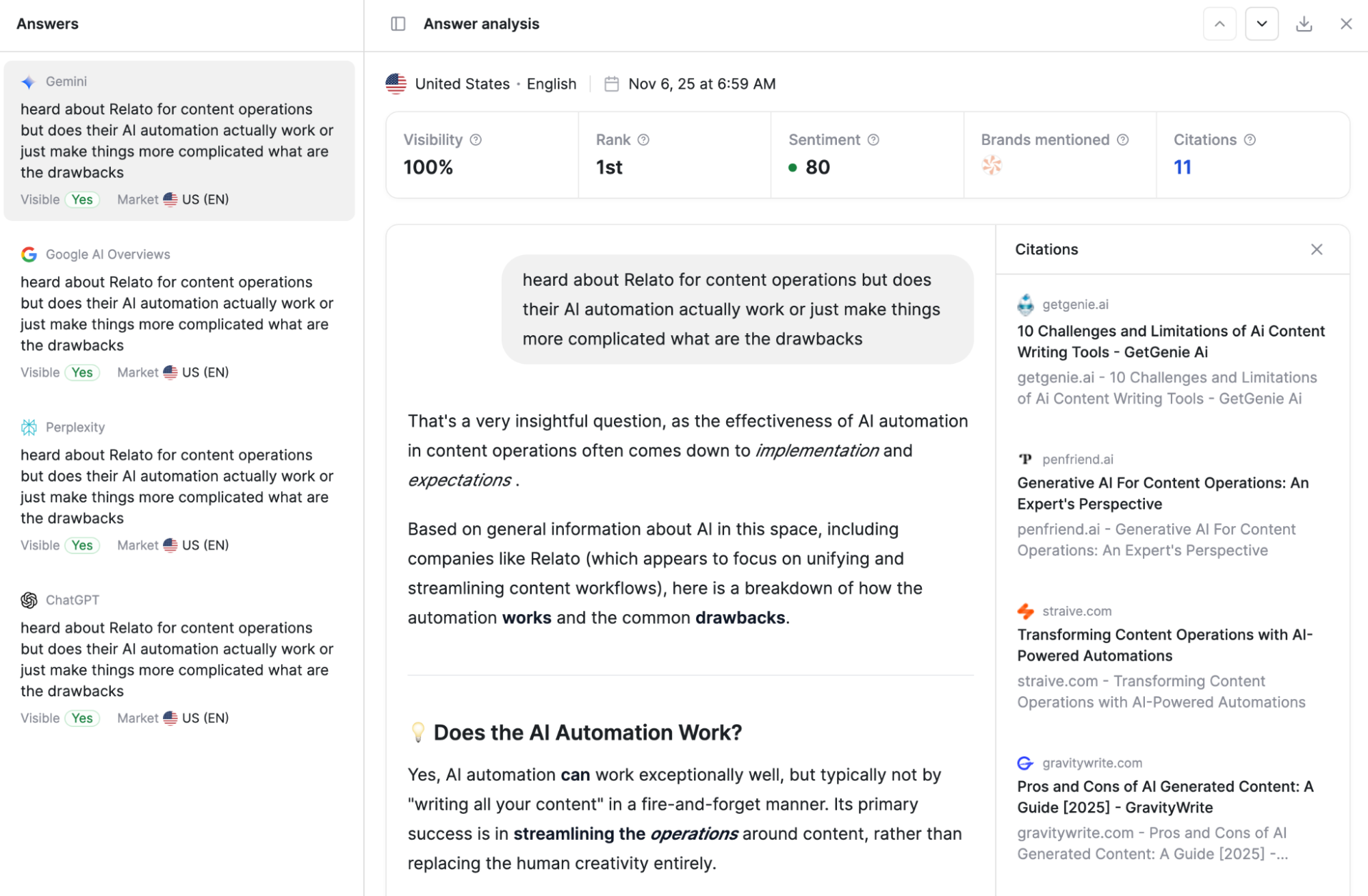
Here’s how Profound monitors prompts:
Unlike Writesonic, Profound provides prompt volumes so you know which to track in the first place. Then, it provides visibility rank, score, and position metrics for each topic and prompt so you can easily see where you’re winning and where your efforts need work.

Plus, it also tracks executions for each prompt, showing whether your brand was mentioned, what position it appeared in, and which competitors also won a mention.

You can open any response to see the AI answer and analyze where your brand appeared in relation to the competition.
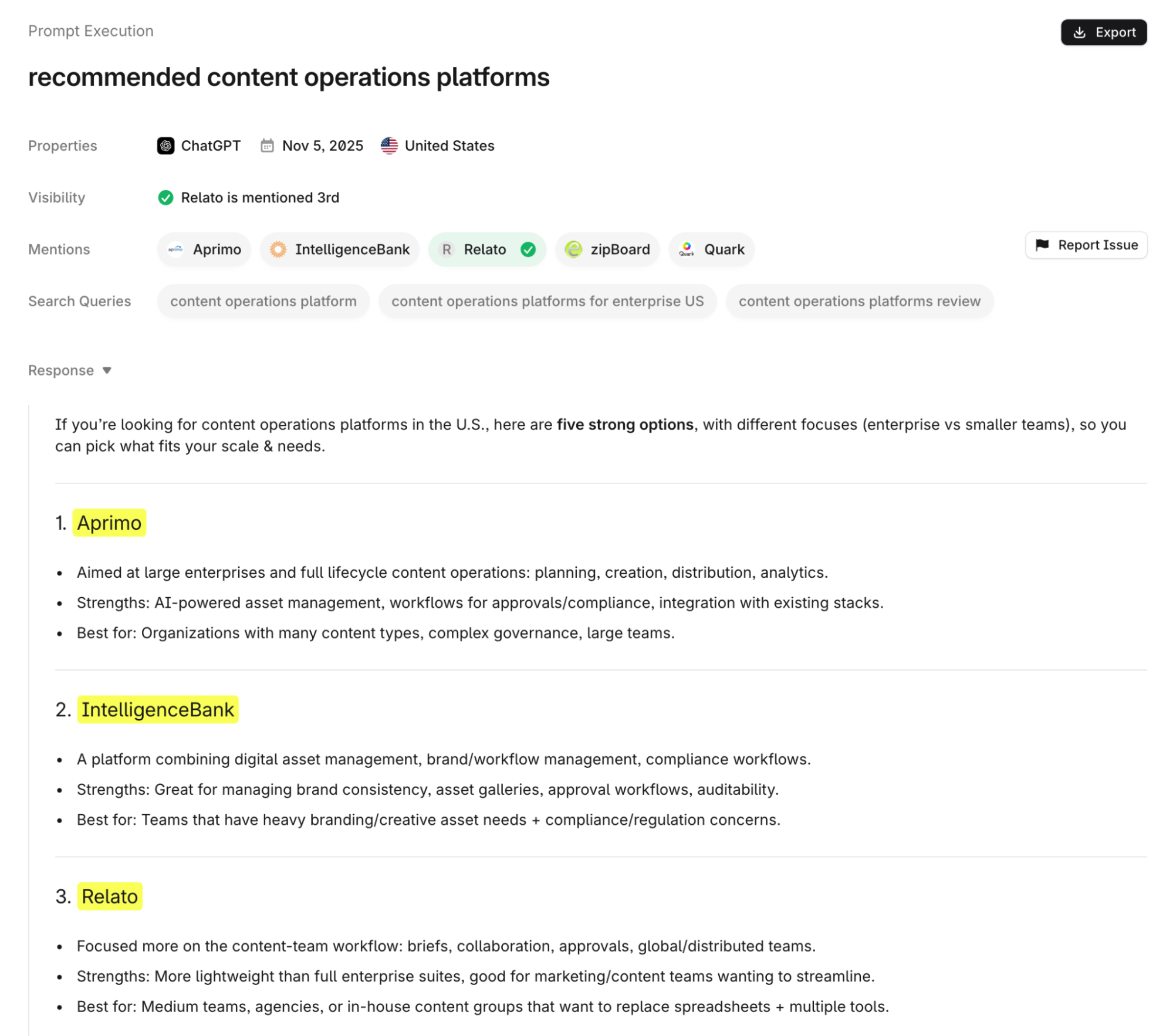
Citations
To optimize your brand’s AI visibility, you also need to track citations. Writesonic keeps a running tally of your brand’s citations, including your top performing pages in AI search. From there, you can review related answers and (manually) reverse engineer more top performing content for your brand.

Writesonic also reveals high-value sources that mention your competitors but not your brand. This could theoretically be helpful for finding opportunities, but in my experience many of the top sources were direct or indirect competitors.
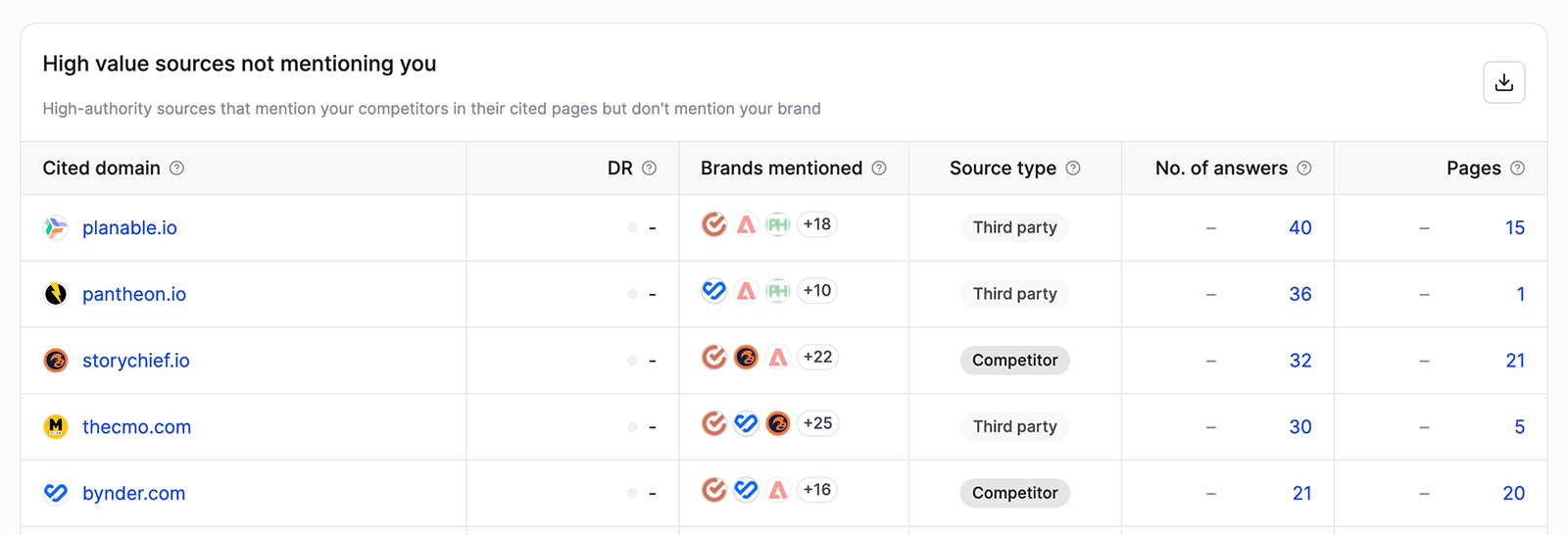
Here’s how Profound handles citations:
It visualizes citation share so you can quickly see how often AI answers cite your brand. It also charts citation rank so you can gauge how often your website is cited in these answers.

Profound also lists the top domains and pages cited in relevant AI answers. You can break these down by topic to focus on specific areas where you want to improve citations. You can also view any domain or page to get a full breakdown of how and when it’s cited.

Sentiment
Ideally, most of your brand’s mentions are positive in nature. Writesonic’s sentiment dashboard breaks down your sentiment distribution over time and charts top positive and negative keywords in your mentions.
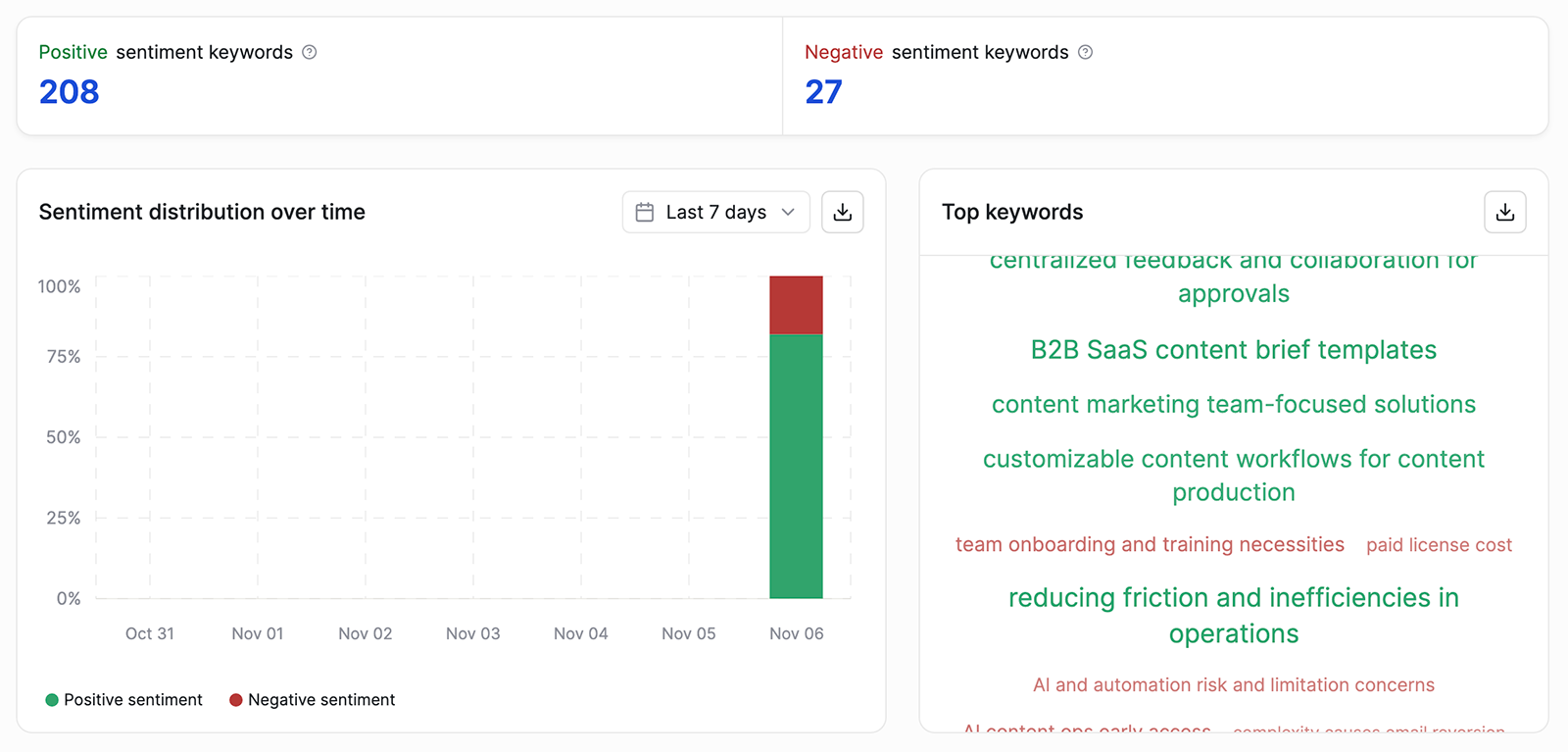
For a deeper analysis, you can click to view answers that include each keyphrase. From there, you can assess the context and determine if you need to do damage control to address negative sentiment or double down on content that generates positive sentiment.
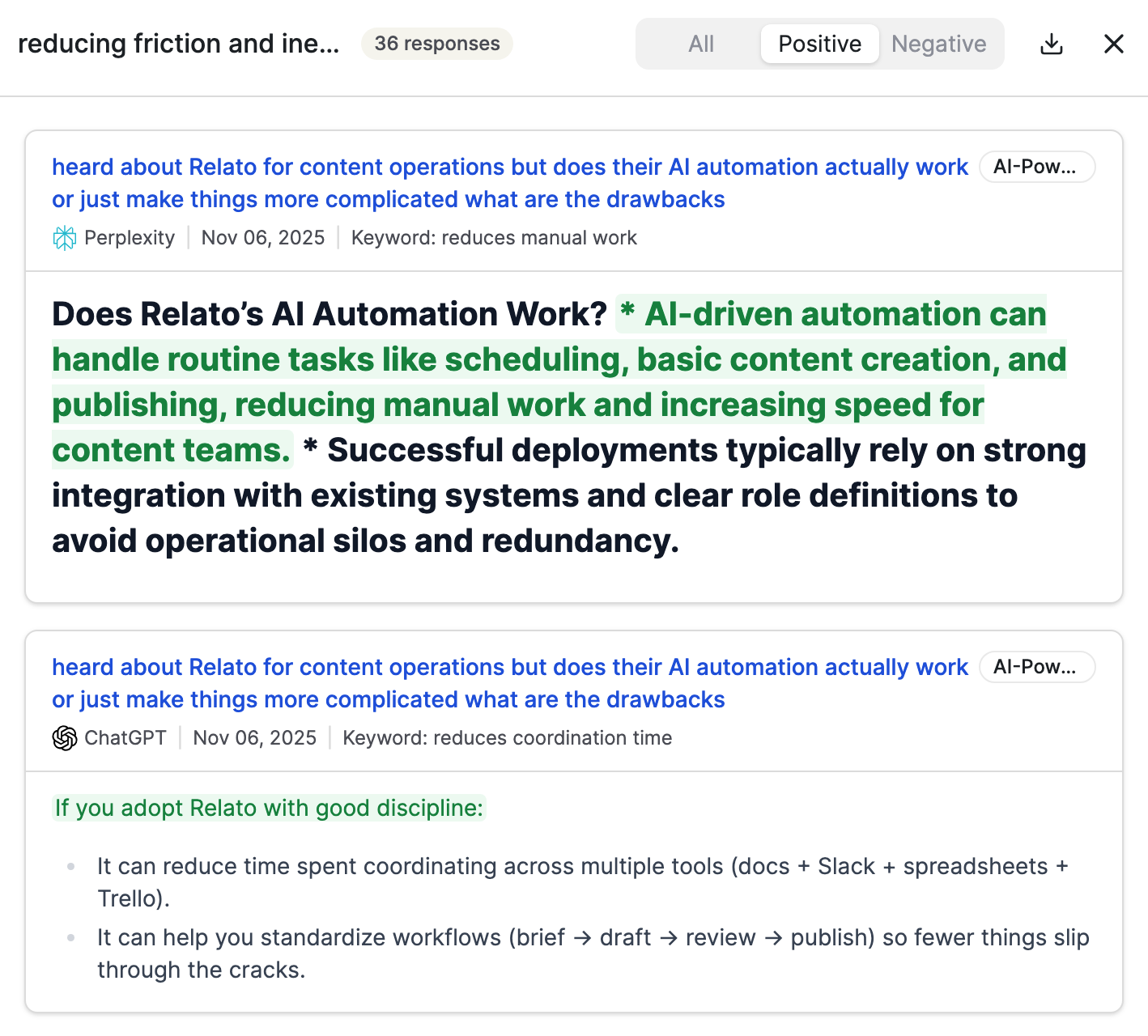
Here’s how Profound measures sentiment:
It visualizes positive and negative sentiment for your brand, quantifying the overall sentiment and highlighting keywords.
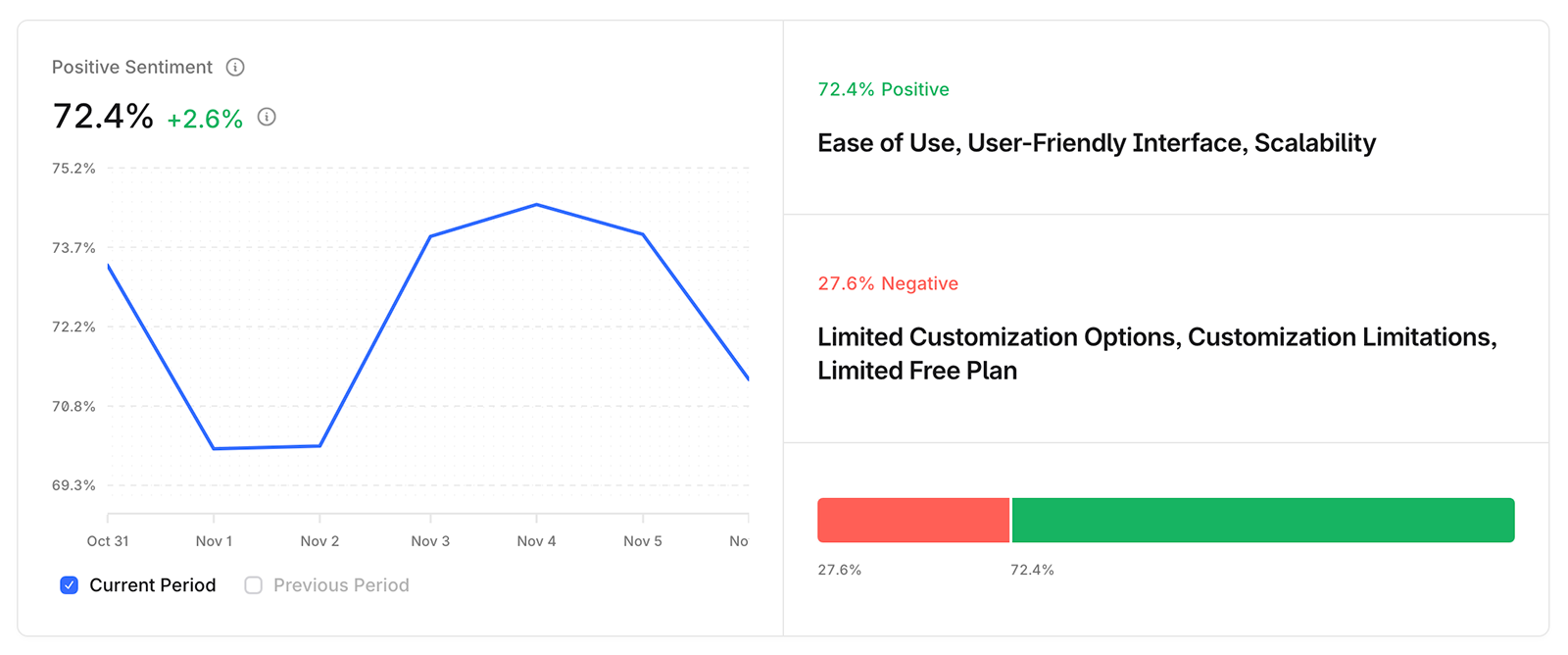
Profound also categorizes responses by theme. You can scroll through each theme to view relevant responses and see how answer engines talk about your brand.

AI bot analytics
Writesonic can reveal how AI crawlers see and interact with your content. To enable this feature, you have to integrate the platform with your website provider. Currently, Writesonic, only supports WordPress, Vercel, and Cloudflare which is a much more limited set of integration partners compared to Profound.
Profound also tracks AI-sourced traffic and attribution across your domains. In addition to Cloudflare and Vercel, Profound’s Agent Analytics integrates with Google Analytics, AWS Cloudfront, Cloudflare, Vercel, Netlify, Fastly, Akamai, and other providers.
Actions to improve AI visibility
It’s important to note that the Writesonic Action Center is only available with the Enterprise plan. So if you opt for one of the platform’s self-serve plans, you won’t get access to any actionable recommendations.
The Action Center breaks everything down by effort level and impact. In theory, this can help you prioritize the most valuable actions. But in practice, almost every action item is high-impact and high- or medium-effort—so it’s not easy to know where to start.
Mentions
Mentions are crucial for AI visibility, and Writesonic shows you which pages offer the most valuable opportunities for your brand, based on number of answers and domain rating.
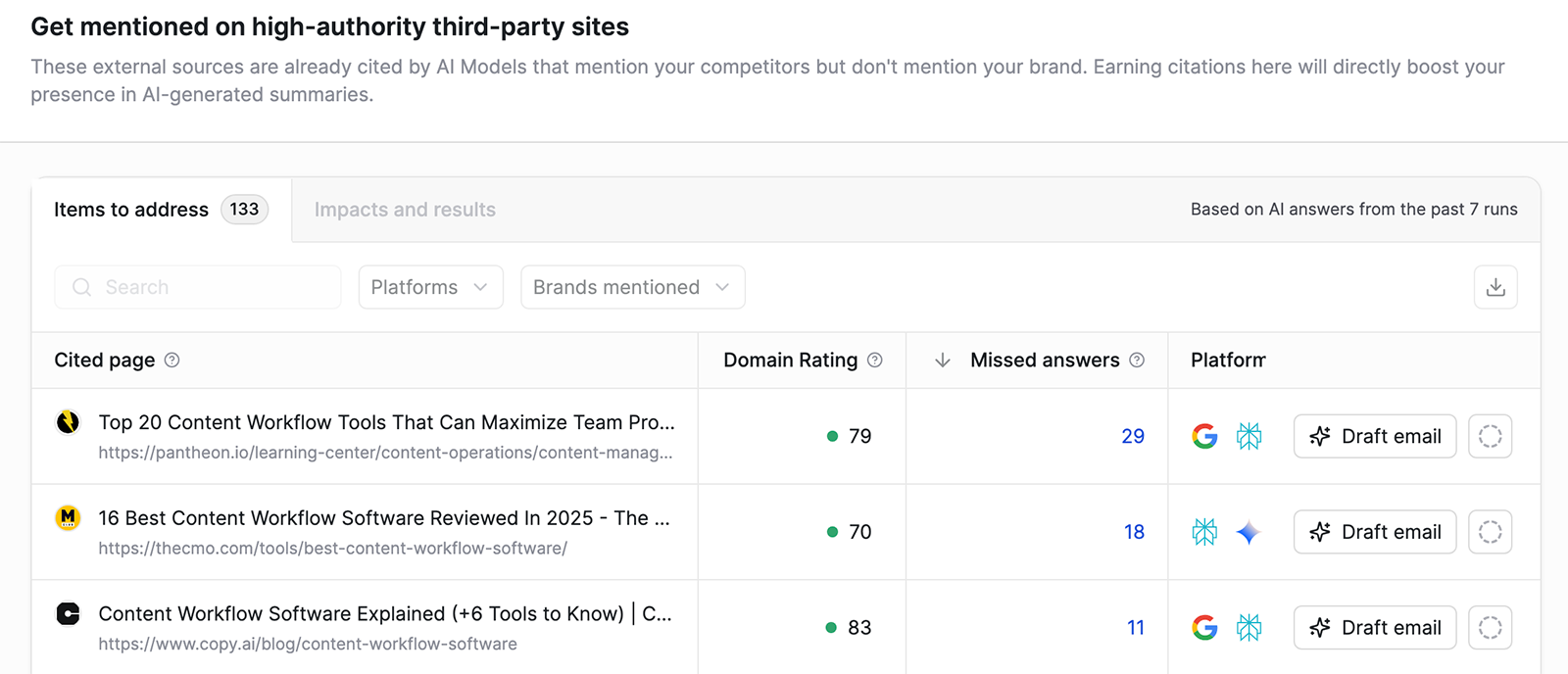
The platform can help you draft outreach emails for these opportunities—but let’s just say this isn’t an email that’s likely to get a positive (or any) response.
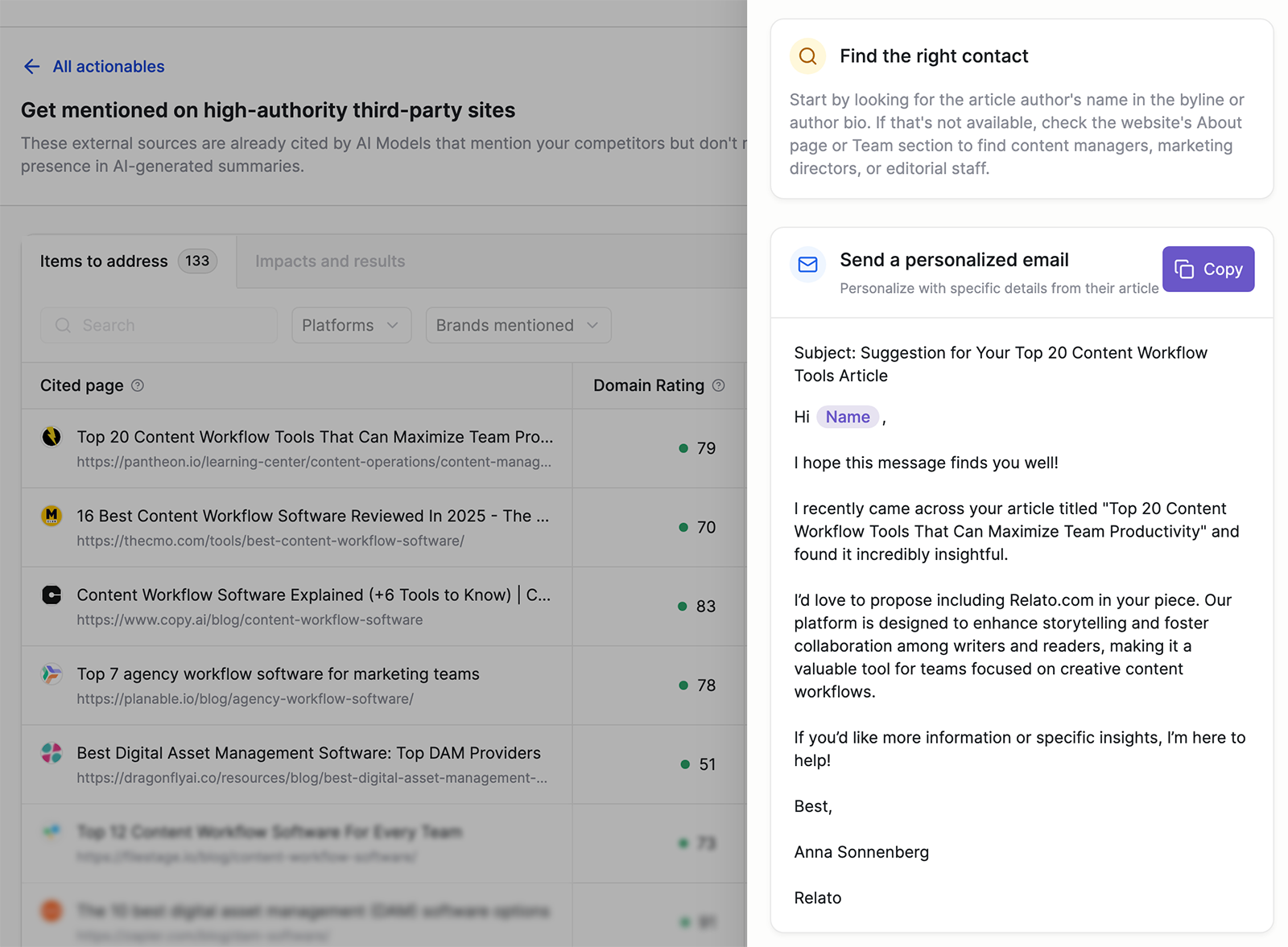
While the Action Center also breaks down opportunities for mentions on UGC and community sites, the one suggestion I received—a TrustRadius comparison page that wouldn’t be possible to influence—was questionable.

Content generation and optimization
The Action Center suggests content ideas based on what’s helping competitors win AI citations. This could be helpful if the ideas were relevant and the content quality was high. But in my experience, neither were true.
The recommended ideas weren’t relevant to the brand (“Content Management Systems for Story Writers” for a B2B content operations platform), which made me wonder if Writesonic had actually analyzed the brand and its competition.
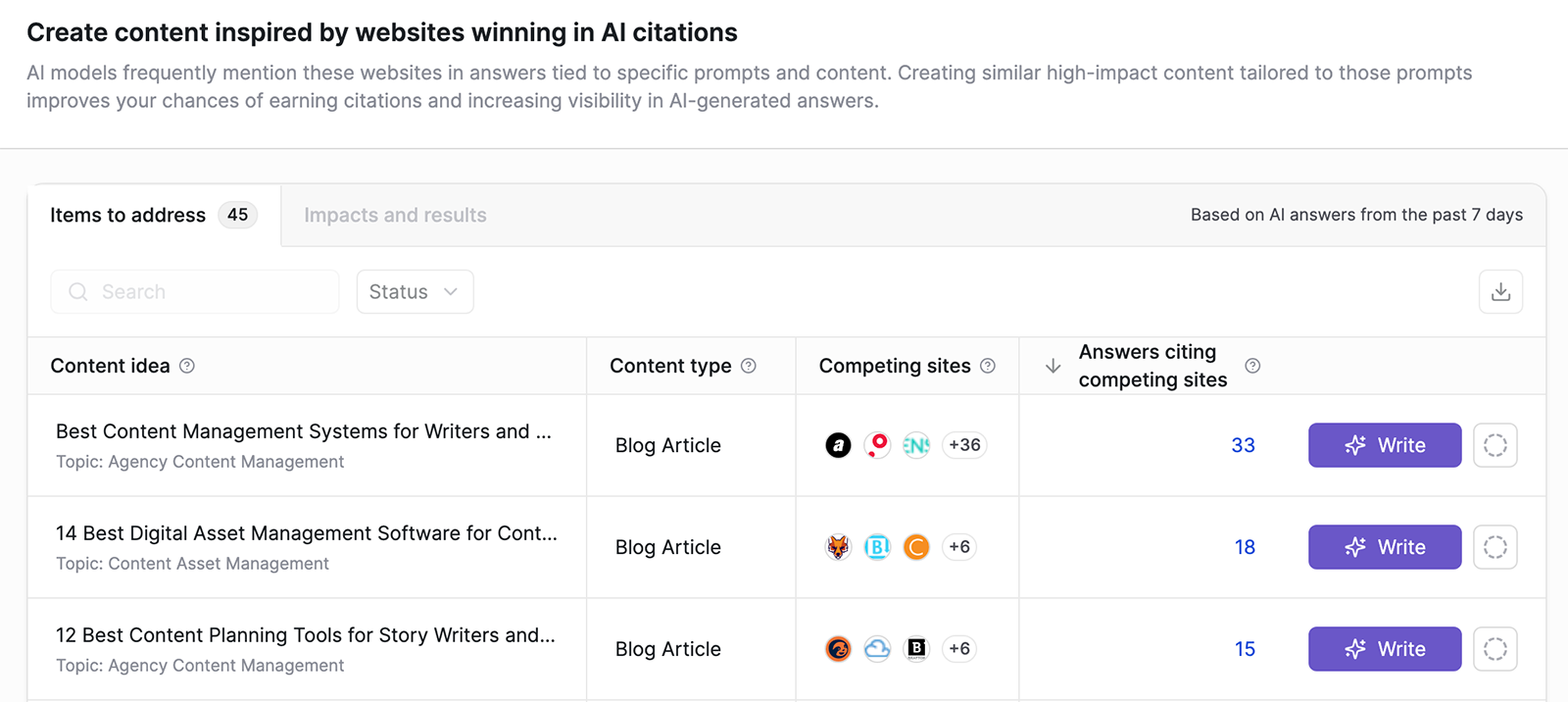
And even after I tweaked the ideas and prompted something that fit the brand, the suggested outlines were unhelpful at best. First, they only included a list of H2 and H3 subheadings, without sharing any reasoning or insight. Worse, the listicle outlines didn’t even include the brand we were optimizing for—which would make them useless for winning AI mentions.
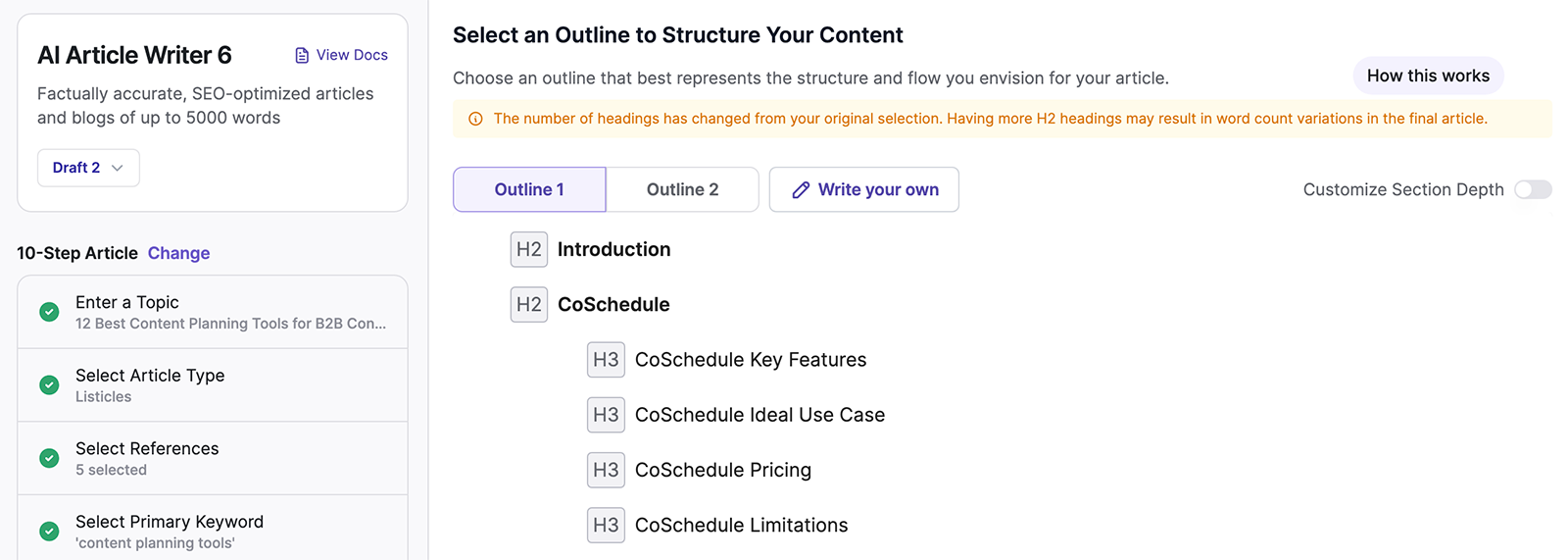
After manually adding the brand and generating an article, I’d give the finished product a C-. I did appreciate that it created or sourced images and that it provided a list of references at the end. But I didn’t love that it didn’t follow brand guidelines or include any inline links to original data.

Interestingly, Writesonic tallied the estimated time savings for the content generation process, claiming it helped me save a whopping 123 hours. But an editor would need to manually verify all the claims and incorporate the brand voice before publishing, so in reality, it wouldn’t save much time at all.
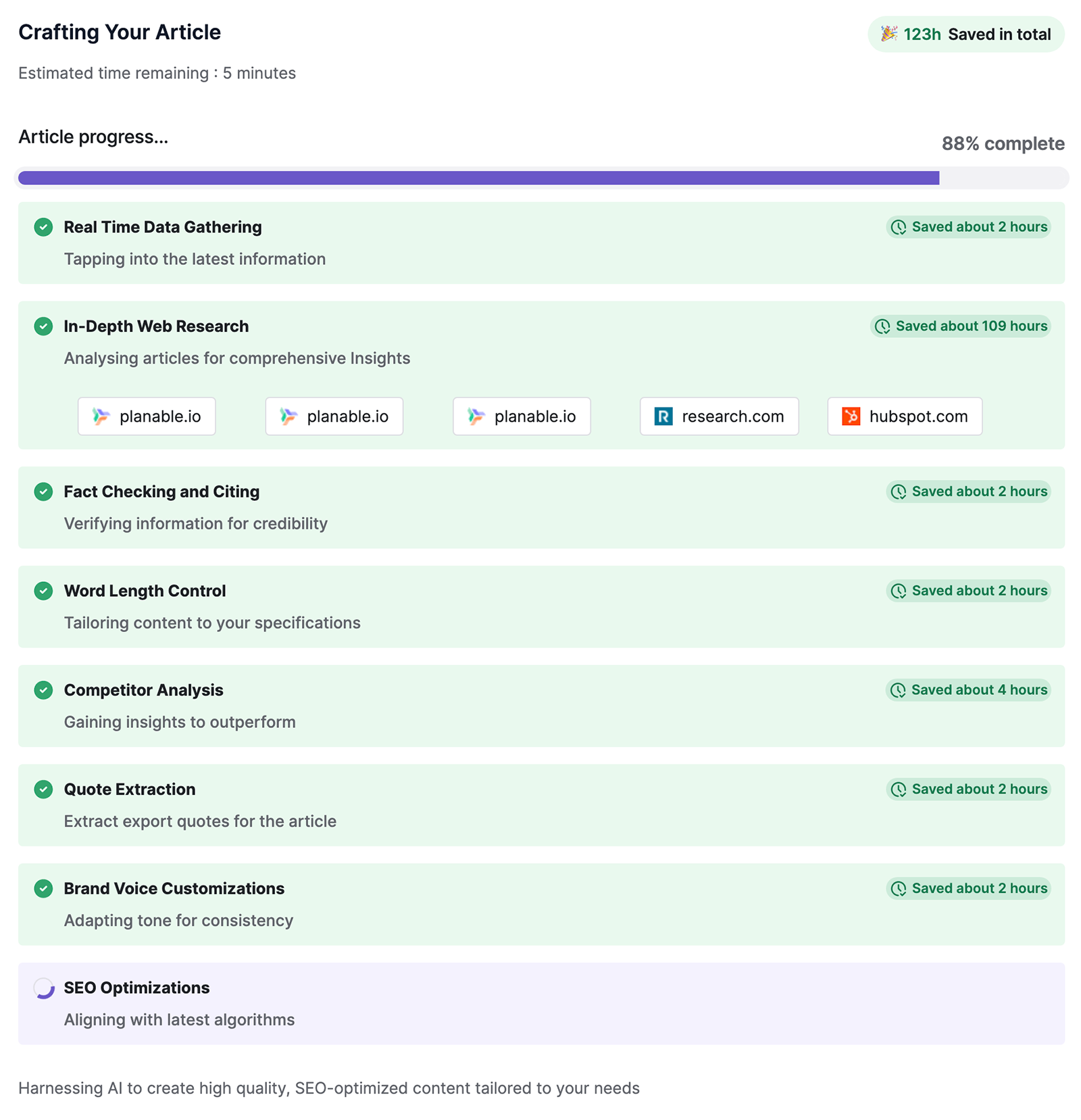
In theory, the Action Center also includes content refresh ideas, which would help with optimizing existing content. But this appears to be a “coming soon” feature.
Profound’s recommendations and content generation tools
Instead of overwhelming you with dozens of to-do list items, Profound provides a shortlist of relevant opportunities for your brand. For example, it suggests new content to prioritize, which subreddit to join and what to say, and where to send outreach to improve visibility.
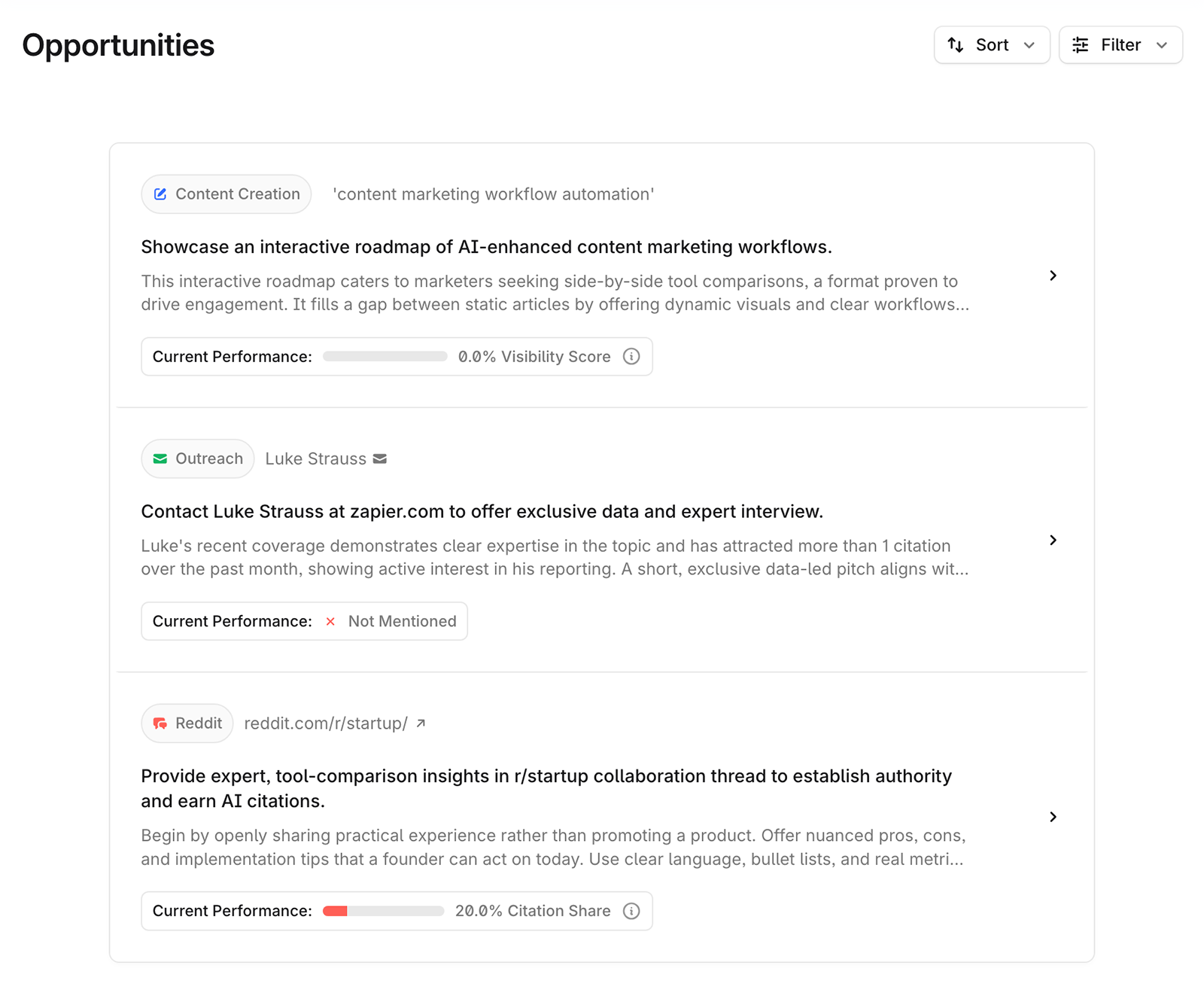
From your Profound dashboard, you can select any opportunities to view the step-by-step implementation suggestions, reasoning for the recommendation, and references to back it up. If your team needs to build a case for pursuing any of these opportunities, this rationale is essential.

While Profound doesn’t assist with drafting outreach emails, it does generate new and optimized content. Select any content creation suggestion and then confirm the topic, prompt, and article title. You can also select the brand kit to use and the answer engines to optimize for.
Profound then analyzes relevant citations, does deep research on the topic, and produces an outline optimized for your brand’s AI visibility.
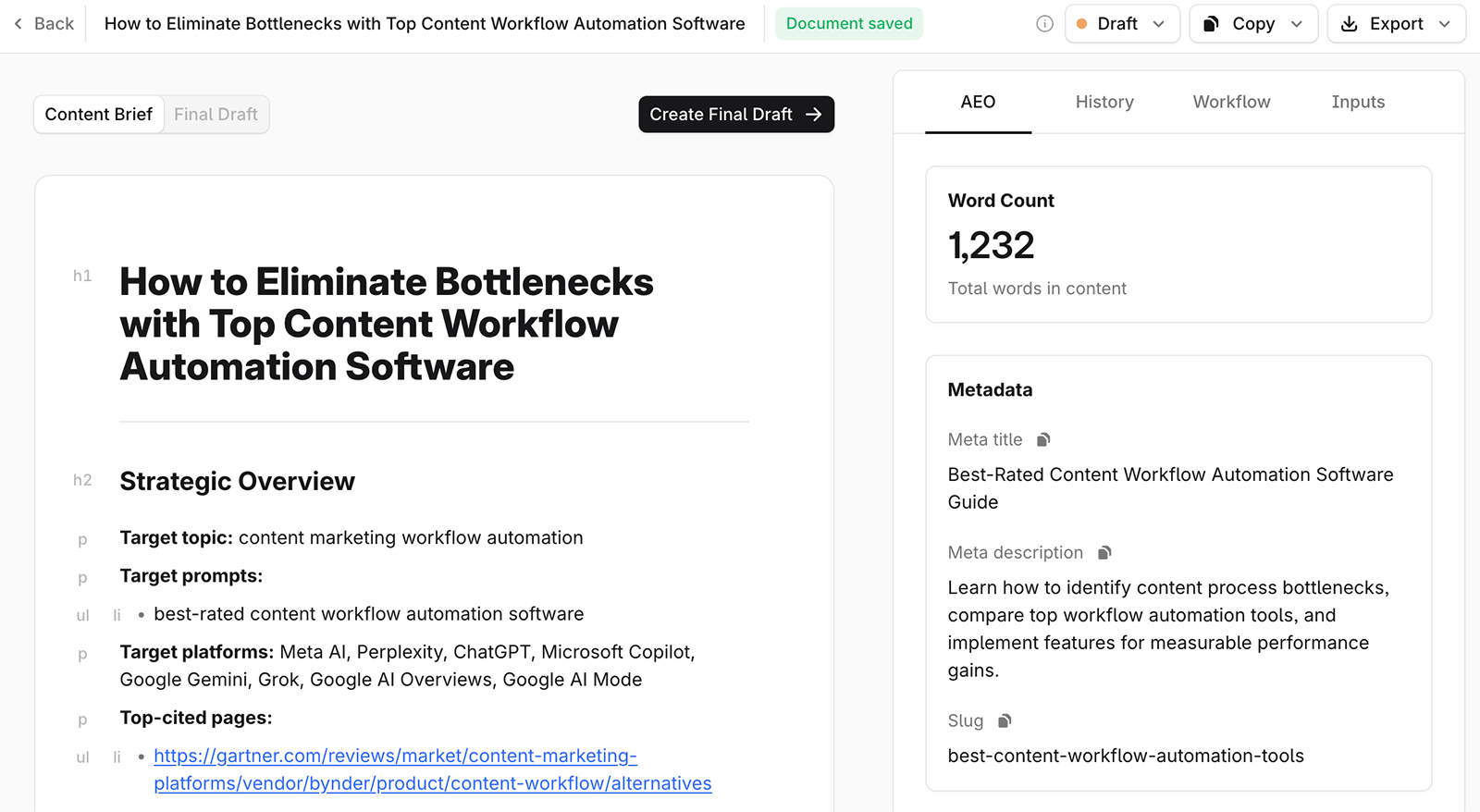
After making any adjustments to the outline and reviewing the newly generated article, you can request changes. For example, I prompted Profound to make this already good article sound more conversational to better fit the audience I had in mind.
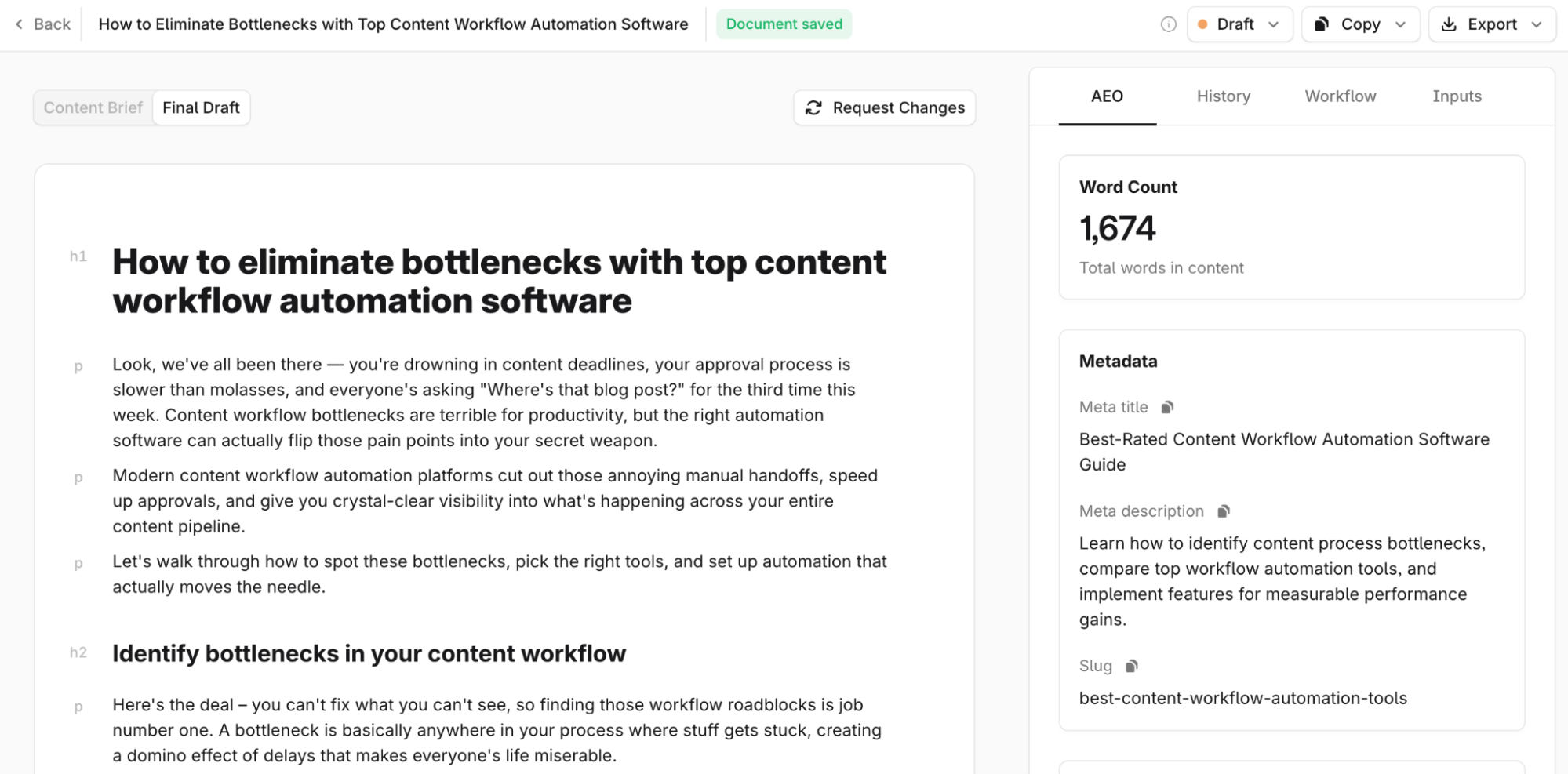
Pricing and subscription options
As an all-in-one platform for AI search tracking, SEO strategy, and content automation, Writesonic has several subscription options. Basic SEO and AI writing plans start at $49 per month, while AI search tracking and optimization plans start at $249 per month.
But the entry-level AI search tracking plan (Professional; $249 per month) is pretty stripped down. It includes 100 AI prompts and three major AI answer engines, but it’s missing prompt recommendations, sentiment analysis, and content creation.
The mid-tier AI search tracking plan (Advanced; $499 per month) includes prompt recommendations and sentiment analysis—but it’s still missing all AI visibility action center features. That’s a significant jump in price without much to show for it.
To get access to eight major AI answer engines (Writesonic doesn’t yet support Meta AI and DeepSeek) and all AI visibility and content creation features, you’d need the Enterprise plan.
In contrast, Profound has three plans. All focus on AI visibility tracking:
- Starter plan ($99/month): Tracks 50 prompts across ChatGPT (
- Growth plan ($399/month): Tracks 100 prompts across ChatGPT, Perplexity, and Google AI Overviews and includes AI content generation and optimization
- Enterprise plan (tailored pricing): Tracks a custom number of prompts across all 10 major AI engines, supports ChatGPT Shopping, and includes AI content generation and optimization
What real users say about Writesonic
Over more than four years, Writesonic has amassed thousands of reviews. On G2 alone, it has more than 2,000 reviews—most of which are positive.
But because Writesonic launched as an AI writing tool and pivoted to an SEO strategy tool before offering AI visibility tracking, almost all of its reviews focus on its earlier capabilities. Very few—maybe 10 out of 2,000—of its G2 reviews mention AI visibility or GEO.
But some reviews of Writesonic’s generative AI tools question the quality of the content. For example, this review mentions that the tool is a lot like using a more expensive version of ChatGPT.
Rohan T. (Marketing Team, Mid-Market 51–1000 emp.)
“The quality of all the contents totally depends on the prompts that we provide from our side and their premium plan is also a little costly for us. Sometimes I just feel that these contents are just like ChatGPT only, but we pay extra every month for its premium plan without getting any additional features.”
As a much newer platform, Profound naturally has far fewer user reviews. Yet it does have 135+ G2 reviews, which are overwhelmingly positive.
For example, this G2 review explains that Profound is unique in the space due to its in-depth analytics and AI shopping visibility tools.
Giacomo P. (Senior Demand Generation Manager)
“Profound shows me data that is super helpful for my website and helps in understanding the changing landscape of citations and usage over time. Overall, the tool is very strong, and its core functionalities strongly align with my requirements.”
And this review highlights how Profound offers visibility tracking, competitor analysis, and actionable insights that help with operationalizing AI visibility strategies.
Kevin M. (CEO & Co-Founder, Mid-Market)
“It provides actionable insights you won't find elsewhere and helps operationalize strategies around AI visibility. Every action my team takes is based off of the data in this platform.”
In addition, Profound is mentioned in dozens of Reddit conversations about AI visibility. Redditors frequently recommend Profound as a strong option for analyzing AI search.
How Writesonic compares to Profound
Let’s look at how Writesonic and Profound’s mid-tier plans compare in terms of AI visibility features, capacity, and pricing.
Writesonic Vs Profound: Self-Serve Plans
Writesonic Vs Profound: Enterprise Plans
When to choose a Writesonic alternative like Profound
If your main goal is monitoring AI visibility, Writesonic’s Advanced plan might fit the bill. It tracks prompts, citations, and sentiment across top AI answer engines, giving you the data you need to understand your brand performance. Because it includes SEO-focused content strategy and generative AI tools, it might also help with content creation and optimization.
But if you’re looking to track AI visibility and create content optimized for AI search, Profound is a better choice. It doesn’t limit AI visibility opportunities or content creation tools to enterprise users, so you can access them without building a custom plan.
Plus, Profound’s Workflows are engineered to create content that gets cited by answer engines. And its content creation tools use your brand guidelines to create unique content that’s designed for your audience. That means you can rely on Profound to help you create content that resonates with your audience and improves your AI visibility.
Profound is also better suited for enterprise users. The platform meets stringent enterprise security requirements—holding SOC Type II certification, supporting role-based access control, and providing data encryption and audit logging.
For enterprise organizations with global reach, Profound delivers multi-region and multi-language monitoring at scale. It supports 30+ languages and 150+ regions. The platform also integrates with BI, CDP, and collaboration tools like Tableau, Power BI, Looker, Snowflake, and many more.
Profound’s deep AI visibility insights, generative AI tools, and actionable recommendations have attracted companies of all sizes and at every growth stage. From Figma and Clay to Dentsu and Edelman, the most innovative companies in the world rely on Profound for AI visibility.
If you need industry-leading AI visibility—not just rebranded SEO tools—Profound delivers best-in-class prompt monitoring, strategic analysis, and workflows that scale for agencies and enterprises. Get started with Profound today.